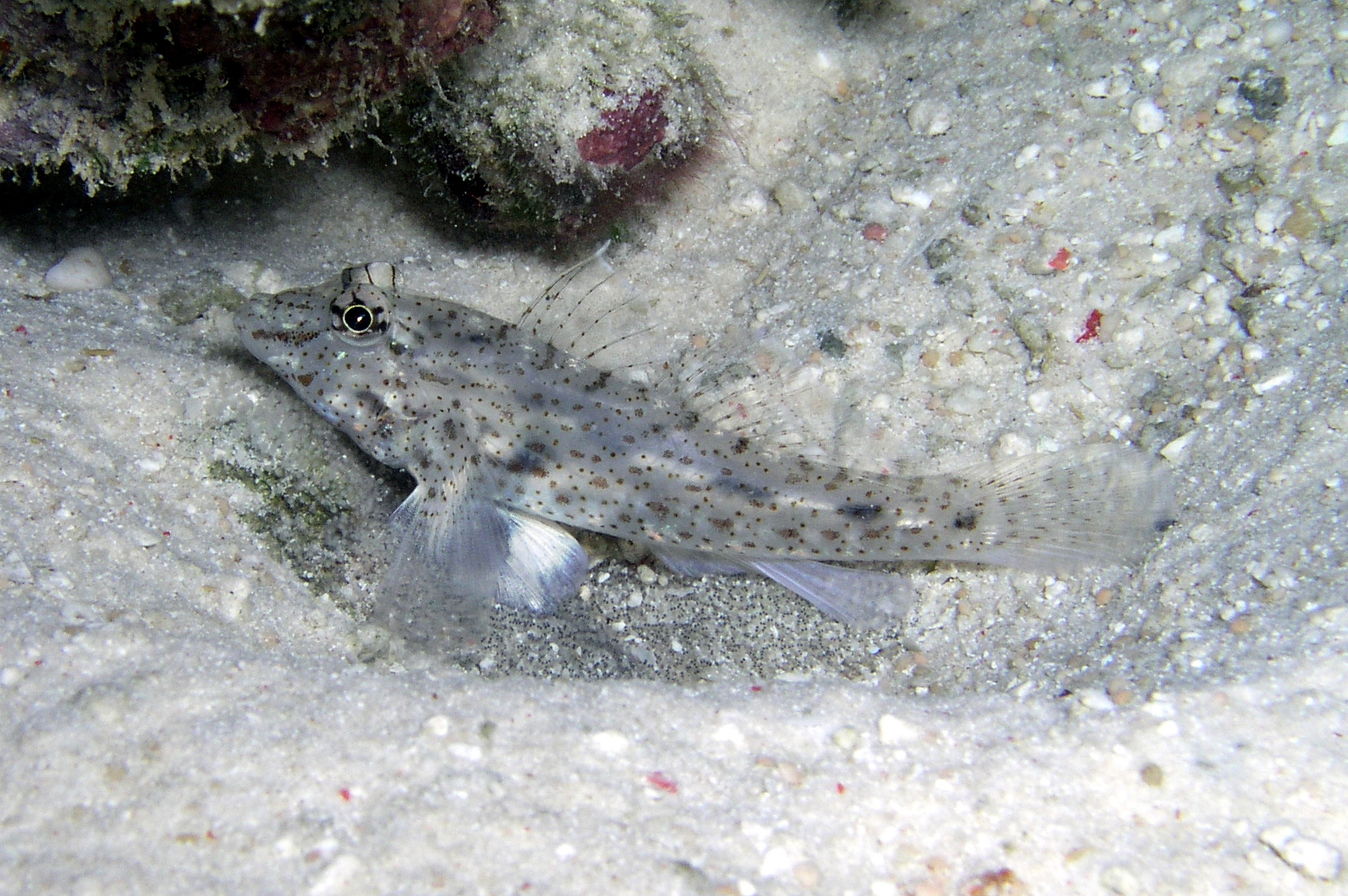Neophyte Sandgoby, Fusigobius neophytus (Günther 1877)
Other Names: Neophyte Goby, Sand Goby

A Neophyte Sandgoby, Fusigobius neophytus, at Northwest Islet, Great Barrier Reef, Queensland, Nov 2004. Source: Sascha Schultz / iNaturalist.org. License: CC by Attribution-NonCommercial
Summary:
A translucent greyish sandgoby with small white and brown spots on the head and body, short dark bands slanting along the back, and a small black spot at the front of the dorsal fin.
Cite this page as:
Bray, D.J. 2022, Fusigobius neophytus in Fishes of Australia, accessed 01 Jul 2025, https://fishesofaustralia.net.au/home/species/120
Neophyte Sandgoby, Fusigobius neophytus (Günther 1877)
More Info
|
Distribution |
Shark Bay area to Scott Reef, Western Australia, and Ashmore Reef in the Timor Sea, and the northern Great Barrier Reef, Queensland, to far northern New South Wales; also Cocos (Keeling) Islands in the eastern Indian Ocean, and the Lord Howe Province in the Tasman Sea. Elsewhere the species occurs in the tropical, Indo-west-central Pacific. Inhabits sandy and rubble patches on reef flats and in shallow lagoons. |
|
Features |
Dorsal fin VI + I, 9; Anal fin I, 8; Pectoral fin 16-19; Longitudinal scale series 22-24. Body depth 4.0-4.6 in SL; pelvic fins fully united; pelvic frenum well developed; gill opening extending almost to below rear edge of opercle; scales mosly ctenoid including those on nape; cycloid scales on breast and pectoral-fin base; operculum naked; median predorsal scales absent, 5-6 scales on side of nape anterior to dorsal fin origin; caudal fin rounded. |
|
Colour |
Body semi-translucent grey, with small brown spots on head and body, and slanting dark bands along the back. |
|
Etymology |
The specific name neophytus is from the Greek neos (= new) and phyton (= plant, tree) - the allusion not explained. |
|
Species Citation |
Gobius neophytus Günther 1877, Journal Museum Godeffroy 4(13): 174, pl. 108(E). Type locality: Ponape, Huahine, Tahiti and Apia, Samoa. |
|
Author |
Bray, D.J. 2022 |
|
Resources |
Neophyte Sandgoby, Fusigobius neophytus (Günther 1877)
References
Allen, G.R. 1993. Fishes of Ashmore Reef and Cartier Island. Records of the Western Australian Museum, Supplement 44: 67-91.
Allen, G.R. & Erdmann, M.V. 2012. Reef fishes of the East Indies. Perth : Tropical Reef Research 3 vols, 1260 pp.
Allen, G.R., Hoese, D.F., Paxton, J.R., Randall, J.E., Russell, B.C., Starck, W.A., Talbot, F.H. & Whitley, G.P. 1976. Annotated checklist of the fishes of Lord Howe Island. Records of the Australian Museum 30(15): 365-454 figs 1-2
Allen, G.R. & Smith-Vaniz, W.F. 1994. Fishes of Cocos (Keeling) Islands. Atoll Research Bulletin 412: 1-21.
Brandl, S.J., Quigley, C.N., Casey, J.M., Mercière, A., et al. 2022. Metabolic rates mirror morphological and behavioral differences in two sand-dwelling coral reef gobies. Marine Ecology Progress Series 684: 79-90. https://doi.org/10.3354/meps13968
Cole, K.S. 1990. Patterns of gonad structure in hermaphroditic gobies (Teleostei: Gobiidae). Environmental Biology of Fishes 28: 125-142.
Francis, M. 1993. Checklist of the coastal fishes of Lord Howe, Norfolk, and Kermadec Islands, southwest Pacific Ocean. Pacific Science 47(2): 136-170 figs 1-2
Gill, A.C. & Reader, S.E. 1992. Fishes. pp. 90-93, 193-228 in Hutchings, P. (ed.) Reef Biology. A Survey of Elizabeth and Middleton Reefs, South Pacific. Canberra : Australian National Parks Vol. 3, Kowari 230 pp.
Greenfield, D. & Munroe, T.A. 2016. Fusigobius neophytus. The IUCN Red List of Threatened Species 2016: e.T193167A2203616. http://dx.doi.org/10.2305/IUCN.UK.2016-3.RLTS.T193167A2203616.en. Downloaded on 10 January 2019.
Günther, A. 1877. Andrew Garrett's Fische der Südsee. Heft 6. Journal des Museum Godeffroy, Hamburg 4(13): 169-216 pls 101-120
Hutchins, J.B. 1994. A survey of the nearshore reef fish fauna of Western Australia's west and south coasts — The Leeuwin Province. Records of the Western Australian Museum, Supplement 46: 1-66 figs 1-6
Johnson, J.W. 1999. Annotated checklist of the fishes of Moreton Bay, Queensland, Australia. Memoirs of the Queensland Museum 43(2): 709-762.
Johnson, J.W. 2010. Fishes of the Moreton Bay Marine Park and adjacent continental shelf waters, Queensland, Australia. pp. 299-353 in Davie, P.J.F. & Phillips, J.A. Proceedings of the Thirteenth International Marine Biological Workshop, The Marine Fauna and Flora of Moreton Bay. Memoirs of the Queensland Museum 54(3)
Kuiter, R.H. 1992. Tropical Reef-Fishes of the Western Pacific, Indonesia and Adjacent Waters. Jakarta : PT Gramedia Pustaka Utama 314 pp. pls.
Kuiter R.H. & Tonozuka, T. 2001. Indonesian Reef Fishes. Part 3. Jawfishes - Sunfishes, Opistognathidae - Molidae. Melbourne : Zoonetics pp. 623–893.
Larson, H.K. & Murdy, E.O. 2001. Eleotridae, Gobiidae. pp. 3574-3604 in Carpenter, K.E. & Niem, T.H. (eds). The Living Marine Resources of the Western Central Pacific. FAO Species Identification Guide for Fisheries Purposes. Rome : FAO Vol. 6 pp. 3381-4218.
Myers, R.F. 1999. Micronesian Reef Fishes. A comprehensive guide to the coral reef fishes of Micronesia. Guam : Coral Graphics vi 330 pp. 192 pls.
Nakamura, Y., Horinouchi, M., Nakai, T. & Sano, M. 2003. Food habits of fishes in a seagrass bed on a fringing coral reef at Iriomote Island, southern Japan. Ichthyological Research 50: 15-22.
Randall, J.E. 1995. Fusigobius Whitley, a junior synonym of the gobiid fish genus Coryphopterus. Bulletin of Marine Science 56(3): 795-798. (as Coryphopterus neophytus)
Randall, J.E. 2005. Reef and shore fishes of the South Pacific. New Caledonia to Tahiti and the Pitcairn Islands. Honolulu : University of Hawaii Press 707 pp. (as Coryphopterus neophytus)
Randall, J.E., Allen, G.R. & Steene, R. 1990. Fishes of the Great Barrier Reef and Coral Sea. Bathurst : Crawford House Press 507 pp. figs.
Randall, J.E., Allen, G.R. & Steene, R. 1997. Fishes of the Great Barrier Reef and Coral Sea. Bathurst : Crawford House Press 557 pp. figs.
Whitley, G.P. 1930. Additions to the checklist of the fishes of New South Wales No. 3. The Australian Zoologist 6(2): 117-123 fig. 14



